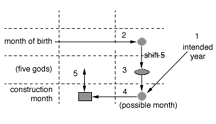APPLICATION OF FENG-SHUI TO BUILDING DESIGN AND CONSTRUCTION
Auspicious Orientation
An auspicious orientation for siting a building in Chinese traditional architecture was based on the theory of eight-building, ba-zhai, which was derived from the eight trigrams. For simplicity, each building was associated with an origin of fortune identified by a trigram and each classified as either east or west. According to the later-heaven order, buildings 1,3,4 and 9 belonged to the east and the rest to the west. There are four steps in the procedure.
This three-cycle index has one of threee values: 0, 1 or 2.
r1 = |
floor((y - 1 + 2367) mod 180 / 60) floor((y+ 2367) mod 180 / 60) |
if y > 0 otherwise |
r2 = |
floor((y - 1 + 2367) mod 60) + 1 floor((y+ 2367) mod 60) |
if y > 0 otherwise |
celestial stem = (r2 - 1) mod 10 + 1 |
terrestrial branch = (r2 - 1) mod 12 + 1 |
r3 = |
(9 - r2 + (1 + 3r1) + 1) mod 9 (r2 + (5 - 3r1) - 1) mod 9 |
if male if female |
good sitings origin of fortune |
N |
NE |
E |
SE |
S |
SW |
W |
NW |
east building |
+ |
. |
+ |
+ |
+ |
. |
. |
. |
west building |
. |
+ |
. |
. |
. |
+ |
+ |
+ |
Propitious Construction Date
Two prevalent methods for determining propitious dates for special events in a person's life. We describe one for a good new construction date, taken from Yang-zhai Shi-shu, based on the person's month of birth. The method is simple and straightforward, and relies on the concept of the 'five gods of innateness', three of whom are good considered harbingers of good fortune. The five gods each control two celestial stems. There are six steps.
- Intended year of new construction
- Terrestrial branch of the person's month of birth
This is calculated as described above.
- Terrestrial branch of the five gods
This is obtained by shifting five places from the terrestrial branch of the person's month of birth.
- Possible construction month
The terrestrial branch of possible construction month in the intended year must coincide with the position of the five gods.
- Fortunate construction month
This is dependent on whether or not the celestial stem of the intended month is controlled by one three gods of good fortune.
- Fortunate day
Yang-zhai Shi-shu identifies twenty days by their stem-branch indices. The days in the fortunate month whose stem-branch indices coincide with one of these twenty are good days to start construction.

Illustrating the first five step.
Fortunate Dimensions
In traditional Chinese architecture most dimensional measurements are related to the dimensions of the central space in the foremost building in the enclosure courtyard. The dimensions of this central space which holds the altar and where the key brick for the building is placed during the ground-breaking ceremony are termed the fortunate dimensions. These are:
- height measured from the lower part of the main beam to the ground
- width measured between the two partition supports of this space, and
- depth, measured from the front entrance to the rear wall.
Typically,
- width <= height and depth =approx 1.3 height.
The fortunate dimensions are measured in Lu Ban feet and inches. There are 10 inches to a Lu Ban foot, which measures 29.69 cm. The following link illustrates the steps involved in calculating the fortunate dimensions.